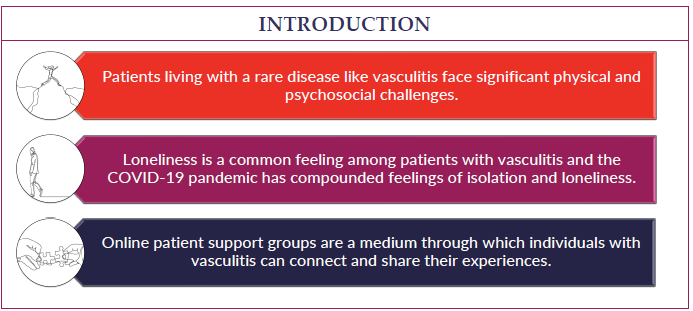Vasculitis Types
About Cogan’s Syndrome
Last Updated on February 5, 2024
Cogan’s syndrome is a rare autoimmune disease that primarily affects the eyes and inner ears, but can also cause inflammation of the blood vessels (vasculitis). Cogan’s syndrome is a form of vasculitis—a family of rare disorders characterized by inflammation of the blood vessels, which can restrict blood flow and damage vital organs and tissues. Cogan’s syndrome primarily affects the large vessels, especially the aorta, which carries oxygenated blood from the heart to the rest of the body.

Quick Facts

Unknown cases worldwide

Unknown US cases

Any onset age, but most common in ages 20-30

Rare in children

Equally split between males and females

More common in caucasians
Cogan’s syndrome is a rare autoimmune disease that primarily affects the eyes and inner ears, but can also cause inflammation of the blood vessels (vasculitis). Cogan’s syndrome is a form of vasculitis—a family of rare disorders characterized by inflammation of the blood vessels, which can restrict blood flow and damage vital organs and tissues. Cogan’s syndrome primarily affects the large vessels, especially the aorta, which carries oxygenated blood from the heart to the rest of the body.
The most common symptoms of Cogan’s syndrome include eye pain and redness, excess tear production, vision impairment, loss of hearing, and dizziness. Associated vasculitis symptoms may include joint and muscle pain, along with heart problems such as congestive heart failure.
Cogan’s syndrome is treated with medications that suppress the immune system including glucocorticoids to control inflammation. In more advanced cases, surgical procedures on the ears, eyes, or even the heart, may be necessary. Early diagnosis and treatment are important to lower the risks of permanent hearing or vision loss. Cogan’s syndrome is a chronic disease with periods of relapse and remission, so ongoing medical care is necessary.
The exact cause of Cogan’s syndrome is not fully understood. It is thought to be an autoimmune disorder—a disease that occurs when the body’s natural defense system mistakenly attacks healthy tissue. For some people, Cogan’s syndrome develops after an infection.
Cogan’s syndrome can occur in people of any age, but most frequently affects young adults in their 20s and 30s. It is very rare. The disease can also occur in people of any race, but is more common in Caucasians.
Cogan’s syndrome typically starts with either eye inflammation or inner ear inflammation, but often progresses to include both. Vasculitis symptoms can be present at the onset of Cogan’s syndrome, or may develop later in the course of the disease. In some cases, symptoms come and go.
The most common symptoms of Cogan’s syndrome include:
- Eye redness and pain, decreased or blurred vision, sensitivity to light, and excess tear production
- Hearing loss, in some cases permanent, accompanied by a sensation of pressure in the ear and/or ringing in the ears (tinnitus)
- Vertigo (a sense of the room spinning) and general dizziness
- Poor balance
- Vasculitis symptoms include muscle pain and cramping, joint pain, headache, fever, and weight loss. Heart murmurs or other heart problems may develop.
Permanent hearing loss is common in patients with Cogan’s syndrome. Vertigo is more severe with initial episodes, tending to improve with time, although poor balance can be persistent. Permanent eye damage and vision loss are uncommon. Vasculitis that affects the aorta can lead to congestive heart failure. Life-threatening complications of Cogan’s syndrome are rare, but may include an aortic aneurysm—an abnormal bulge in a weakened artery wall that can rupture.
The most common symptoms of Cogan’s syndrome include:
- Eye redness and pain, decreased or blurred vision, sensitivity to light, and excess tear production
- Hearing loss, in some cases permanent, accompanied by a sensation of pressure in the ear and/or ringing in the ears (tinnitus)
- Vertigo (a sense of the room spinning) and general dizziness
- Poor balance
- Vasculitis symptoms include muscle pain and cramping, joint pain, headache, fever, and weight loss. Heart murmurs or other heart problems may develop.
There is no single test for diagnosing Cogan’s syndrome, so your doctor will consider several factors including a detailed medical history, physical examination, laboratory tests, specialized imaging studies, and biopsy, when indicated.
Your doctor will attempt to rule out diseases with similar symptoms. These include infections, inflammatory disorders such Crohn’s disease, other vasculitic syndromes, rheumatoid arthritis, and systemic lupus, certain cancers, and multiple sclerosis, among others. In addition, blood tests and urinalyses will likely be ordered.
The diagnosis of vasculitis is usually confirmed in patients with Cogan’s syndrome via:
- Detailed exam by an eye doctor (ophthalmologist) and an ear, nose, and throat specialist (ENT)
- Echocardiography—a cardiac ultrasound
- Magnetic resonance angiography (MRA) for evaluation of blood vessels
- A biopsy of affected tissue—surgical removal and analysis of a small tissue sample from a blood vessel or affected organ
Treatment of Cogan’s syndrome depends on symptoms, severity of disease, and whether vasculitis is present. Glucocorticoid medications are typically started early in the course of Cogan’s syndrome for eye inflammation and decreased hearing.
Mild eye disease may initially be treated with topical steroids and nonsteroidal anti-inflammatory drugs (NSAIDs). For more severe disease, oral glucocorticoids such as prednisone, and other immunosuppressive medications may be prescribed including methotrexate, cyclophosphamide, cyclosporine, mycophenolate mofetil or azathioprine.
If hearing is impaired and does not respond to medications, cochlear implants may help improve hearing. Cochlear implants are surgically implanted electronic devices that provide a sense of sound to those who are deaf or hard of hearing. Medications may also be prescribed to treat balance problems.
When the cornea (the transparent layer forming the front of the eye) has been severely damaged by inflammation, corneal transplants may be an option. A corneal transplant is a surgical procedure that replaces the scarred cornea with another from an organ donor.
If inflammation of the aorta and/or other vessels are proven to be present, treatments include glucocorticoids with other immunosuppressive therapy. Heart problems may require surgical procedures such as aortic valve replacement.
The medications used to treat Cogan’s syndrome have potentially serious side effects such as lowering your body’s ability to fight infection, and potential bone loss (osteoporosis), among others. Therefore, it’s important to see your doctor for regular checkups. Medications may be prescribed to offset side effects. Infection prevention is also very important. Talk to your doctor about getting vaccines (e.g., flu shot, pneumonia and/or shingles vaccination), which can reduce your risk of infection.
Cogan’s syndrome is a chronic disease with periods of relapse and remission. If your initial symptoms return or you develop new ones, report them to your doctor as soon as possible. Regular checkups and ongoing monitoring of laboratory and imaging tests are important in detecting relapses early.
Effective treatment of Cogan’s syndrome may require a team of medical providers. In addition to a primary care doctor, Cogan’s syndrome patients will likely need to see the following specialists:
- Ophthalmologist (eyes)
- Otolaryngologist (ear, nose and throat)
- Rheumatologist (joints, muscles, immune system)
- Cardiologist (heart) or others as needed
The best way to manage your disease is to actively partner with your health care providers. Get to know the members of your health care team. It may be helpful to keep a health care journal to track medications, symptoms, test results and notes from doctor appointments in one place. To get the most out of your doctor visits, make a list of questions beforehand and bring along a supportive friend or family member to provide a second set of ears and take notes.
Remember, it’s up to you to be your own advocate. If you have concerns about your treatment plan, speak up. Your doctor may be able to adjust your dosage or offer different treatment options. It is always your right to seek a second opinion.
Living with a chronic condition such as Cogan’s syndrome can be overwhelming at times. Fatigue, pain, emotional stress, and medication side effects can take a toll on your sense of well-being, affecting relationships, work, and other aspects of your daily life. Sharing your experience with family and friends, connecting with others through a support group, or talking with a mental health professional can help.
Most patients with Cogan’s syndrome respond well to treatment; however, in some cases, the disorder can lead to permanent hearing or vision loss. Early diagnosis and treatment can help minimize these risks. The long-term outlook also depends on whether vasculitis is present and its severity. Cogan’s syndrome is a chronic disease, so ongoing medical care is important.

























































